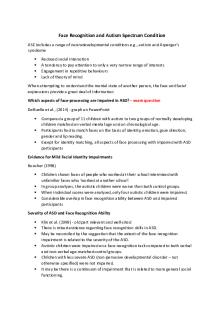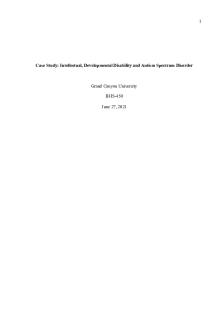Face Recognition and Autism Spectrum Condition PDF

| Title | Face Recognition and Autism Spectrum Condition |
|---|---|
| Course | Face rec |
| Institution | Bournemouth University |
| Pages | 6 |
| File Size | 95 KB |
| File Type | |
| Total Downloads | 101 |
| Total Views | 138 |
Summary
autism...
Description
Face Recognition and Autism Spectrum Condition ASC includes a range of neurodevelopmental conditions e.g., autism and Asperger’s syndrome
Reduced social interaction A tendency to pay attention to only a very narrow range of interests Engagement in repetitive behaviours Lack of theory of mind
When attempting to understand the mental state of another person, the face and facial expressions provide a great deal of information Which aspects of face-processing are impaired in ASD? - exam question DeRuelle et al., (2014) - graph on PowerPoint
Compared a group of 11 children with autism to two groups of normally developing children matched on verbal mental age and on chronological age. Participants had to match faces on the basis of identity, emotion, gaze direction, gender and lip reading. Except for identity matching, all aspects of face processing with impaired with ASD participants
Evidence for Mild Facial Identity Impairments Boucher (1998)
Children shown faces of people who worked at their school intermixed with unfamiliar faces who ‘worked at another school’. In group analyses, the autistic children were worse than both control groups. When individual scores were analysed, only four autistic children were impaired. Considerable overlap in face recognition ability between ASD and impaired participants
Severity of ASD and Face Recognition Ability
Klin et al. (1999) - old part relevant and well-cited There is mixed evidence regarding face recognition skills in ASD. May be reconciled by the suggestion that the extent of the face recognition impairment is related to the severity of the ASD. Autistic children were impaired on a face recognition task compared to both verbal and non-verbal age-matched control groups. Children with less severe ASD (non-pervasive developmental disorder – not otherwise specified) were not impaired. It may be there is a continuum of impairment that is related to more general social functioning.
Emotional Expression Studies - focus of the lecture, where most studies have focused
You do get specific emotions that make sense to the disorder that is being considered Although impairments in all aspects of face processing have been shown in individuals with ASD, most studies have investigated the processing of emotional expression. It has consistently been reported that individuals with ASD are generally poor at expression recognition. Some studies suggest that these deficits are restricted to only certain expressions.
Deficits in Recognizing only some Expressions - Humphreys et al. (2007) (often cited)
Argument that the Ekman test is too easy for perceptual properties of a stimulus, rather than automatic interpretation Adults with Autism and typically developing control group performed 6 alternative forced-choice response to morph all possible combinations of the 6 basic emotions identities by Ekman (rather than 100% of one image of an emotion; 50% is not used as there is no correct answer) - made the test harder ASD participants were particularly impaired at recognizing fear. The degree to which an ASD individual under-recognized fear correlated with the degree to which they were rated as having diagnostic traits of ASD. (severity) ASD participants also showed a lesser impairment in recognizing disgust and happiness. A second experiment demonstrated that the ASD individuals could simply match faces showing the same expression (same task but match up those that show the same expression) – low-level perceptual difficulties cannot underlie their problems in recognizing expressions. (good that they carried out the second study) The impairment may not be common across all emotional expressions, and particular expressions might be affected. (Autistic could do this; not a level of low level perception, it is higher order and how they are interpreting this)
Why is face processing atypical in ASD? Avoidance of facial stimuli - main outward behavioural characteristic of Autism Eye Movement Evidence (II) Klin et al. (2002) - old but very important study
Monitored eye movements while participants watched the movie “Who’s Afraid of Virginia Woolf?” - graph on PowerPoint ASD participants paid less attention to the internal features overall. Less time on the eyes and more on the mouth (flip finding) (more at bodies and objects) Participants who spent longer viewing the mouth had better social abilities than those who avoided the face altogether. Replicated several times (mouth and eyes finding)
Neurological Findings
Support that it is about eye contact
Many reports of decreased FFA activity when individuals with ASD view faces compared to typical people It is possible that this is brought about by an avoidance of the eyes. FFA - linked to looking at the eye region of the face?
Dalton et al. (2005):
FFA activation was correlated with the length of time each ASD participant spent looking at faces.
Hadjikhani et al. (2004):
The reduction in FFA activation disappeared when ASD participants were directed to look at the eyes. - not inbuilt/abnormality, just a case of avoidance/preference
BUT – not always clear the effect is caused by an avoidance of the eyes. (some studies show this is not the case) – conflicting evidence Why is face processing atypical in ASD? (ii) A deficit in configural processing (configural processing at its most relevant) Weak Central Coherence Hypothesis - Katsyri et al. (2008)
Early abnormalities in the visual system could selectively impair face processing while leaving processing of objects intact. - abnormality is in the bias Evidence suggests processing in ASD is biased towards the use of high frequency (HSF) rather than low frequency (LSF) information (the opposite to controls). Typicals are more biased towards low frequency Adults with ASD were impaired at recognizing expressions that only contained LSF information. Presumably because they can’t extract information for configural information so need the detailed (HSF) information, probably to do a feature by feature analysis Configural processing relies on LSF information and featural processing on HSF information
The Face Inversion Effect: Mixed Evidence - does the aforementioned evidence come through? Remember that face inversion disrupts configural processing, forcing the perceiver to use a featural processing strategy.
Several studies failed to find a face inversion effect in ASD participants. McPartland et al. (2004): Did not find the faster N170 for upright faces in ASD participants.
BUT – other studies HAVE found a normal face inversion effect in ASD participants. – conflicting evidence
E.g., Teunisse & de Gelder (2003): Correlation between upright face recognition and degree of social intelligence. A Preference For Featural Information? - An alternative explanation Joseph & Tanaka (2003)
Not so much an impairment, it is a preference for using featural information (visual systems are better set up for this) Participants asked to recognize individual facial features within a whole face or in isolation. Control children were better at recognizing features when they were within the whole face rather than in isolation. ASD children only had a whole face advantage for mouths and were particularly bad at processing the eyes. Suggests configural processing deficit is not absolute and the different strategies can be used to process different parts of the face
Enhanced Perceptual Functioning Mottron et al. (2006) - key finding
This evidence forms the basis of the enhanced perceptual functioning theory. ASD individuals are more proficient at processing fine-grained (local) information than unimpaired participants. They use this superior ability by default. Perception is dominated by fine-detailed information at the expense of global information.
Preference - you will still get this automatic processing, but the individual is saying they will use their featural processing (preference), interference effects Why is face processing atypical in ASD? (iii) Neural dysfunction Faces Processed as Objects? - autistic people may classify faces as an object, so processed in the object pathway of the brain, implementing a different neural system We’ve already discussed how reduced FFA activation may be attributed to an avoidance of the eyes. Alternatively, ASD individuals may use a completely different neural system to controls. Hubl et al. (2003) support:
Increased activation in the object area of the brain (medial occipital gyrus) when ASD individuals looked at faces.
Might account for the preference for fine-grained local information – used in object recognition.
Dysfunction in the Amygdala? Face processing deficits in ASD may be attributed to a dysfunction in the amygdala. Several studies reported abnormal activation while participants view emotional and neutral faces.
Baron-Cohen et al. (2000): Proposed the amygdala theory of autism – deficits in social intelligence might be attributed to an amygdala impairment. Largely based on fMRI evidence that failed to note amygdala activation when ASD participants completed the ‘Mind from the Eyes’ task.
Amygdala/Fusiform Activation Model - Schultz (2005) Study Points and Further Reading Summary A range of face processing deficits can present in ASD, including identity recognition, gaze direction recognition, gender recognition and lip-reading, but most consistently expression recognition. Sometimes only certain expressions are impaired, notably fear. There are several hypotheses about the causes of these impairments. Some authors suggest individuals with ASD simply pay less attention to faces, while others believe these individuals have a preference for a featural processing strategy that is suboptimal for face processing. Much neuroimaging evidence suggests individuals with ASD have abnormalities in the FFA and may instead use object areas of the brain to process faces. Schultz (2005) proposed the amygdala/fusiform modulation theory that accounts for face processing and social interaction difficulties in ASD. However, the theory is challenged by evidence that not all individuals with ASD are impaired at face processing, and developmental prosopagnosics do not show ASD symptoms. Study Points Use the following questions to guide your further reading: What type of face processing impairments are observed in individuals with ASD, and do all individuals with ASD experience these impairments? Explain the evidence and theories that suggest ASD may be associated with a preference for processing fine-grained information. Why would this impact their face processing skills? Describe and evaluate Schultz’s (2005) model that accounts for face processing impairments in ASD.n This Week’s Reading Bate, S. (2012). Face recognition and its disorders. Palgrave Macmillan. Chapter 11
Behrmann et al. (2006). Seeing it differently: Visual processing in autism. Trends in Cognitive Sciences, 10, 258-264. Available here: http://pstorage-cmu-348901238291901.s3.amazonaws.com/12112550/file.pdf
Schultz (2005). Developmental deficits in social perception in autism: The role of the amygdala and fusiform face area. International Journal of Developmental Neuroscience, 23, 125-141. Available here: http://citeseerx.ist.psu.edu/viewdoc/download?doi=10.1.1.543.8270&rep=rep1&type=pdf
Klin et al. (2002). Visual fixation patterns during viewing of naturalistic social situations as predictors of social competence in individuals with autism. Archives of General Psychiatry, 59, 809-816. Available here: https://jamanetwork.com/journals/jamapsychiatry/fullarticle/206705...
Similar Free PDFs

Autism
- 4 Pages
Popular Institutions
- Tinajero National High School - Annex
- Politeknik Caltex Riau
- Yokohama City University
- SGT University
- University of Al-Qadisiyah
- Divine Word College of Vigan
- Techniek College Rotterdam
- Universidade de Santiago
- Universiti Teknologi MARA Cawangan Johor Kampus Pasir Gudang
- Poltekkes Kemenkes Yogyakarta
- Baguio City National High School
- Colegio san marcos
- preparatoria uno
- Centro de Bachillerato Tecnológico Industrial y de Servicios No. 107
- Dalian Maritime University
- Quang Trung Secondary School
- Colegio Tecnológico en Informática
- Corporación Regional de Educación Superior
- Grupo CEDVA
- Dar Al Uloom University
- Centro de Estudios Preuniversitarios de la Universidad Nacional de Ingeniería
- 上智大学
- Aakash International School, Nuna Majara
- San Felipe Neri Catholic School
- Kang Chiao International School - New Taipei City
- Misamis Occidental National High School
- Institución Educativa Escuela Normal Juan Ladrilleros
- Kolehiyo ng Pantukan
- Batanes State College
- Instituto Continental
- Sekolah Menengah Kejuruan Kesehatan Kaltara (Tarakan)
- Colegio de La Inmaculada Concepcion - Cebu














